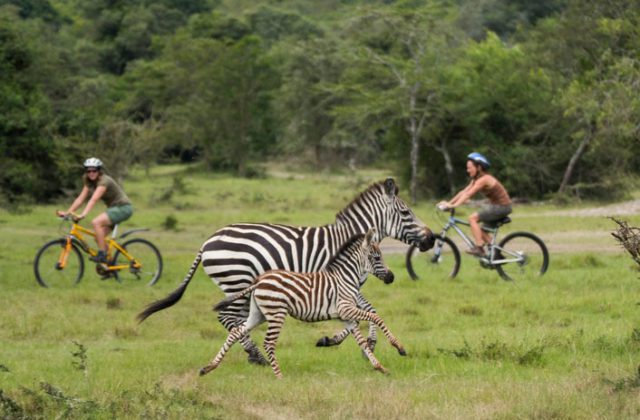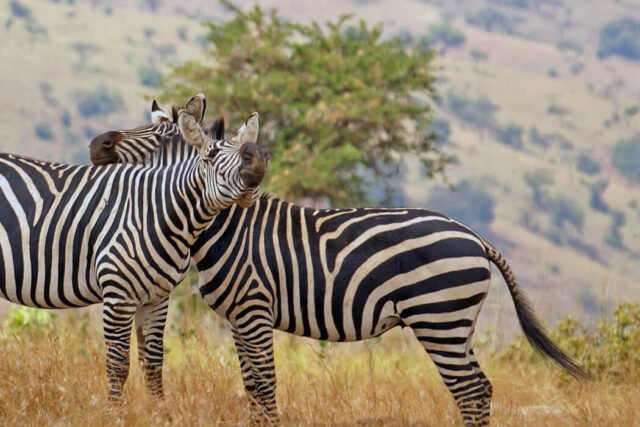Here are some zebra facts, to introduce you to these beautiful animals, their stunning stripes, how they live in the wild and where you can see zebras.
Of all animals in the wild, Zebras must be the easiest to identify – with complete certainty. Even for someone who has never seen a picture of a zebra, it is likely they have seen the zebra crossing on the road. That is all the description anyone needs to know what a zebra is. Like a horse, but with stripes of black and white.
Kidepo Valley National Park and Lake Mburo National Park are the only two Game parks in Uganda that are populated by zebras. There are around 3000 zebras in Uganda.

Their population has not grown so much because of natural factors of climate change – such as longer droughts. Watching zebras go about their day in the savannah is just a mesmerizing sight. Each zebra with its own pattern of stripes and yet they look majestically the same.
Before you come face to face with these fascinating creatures, here are a few zebra facts that you should know.
Interesting Zebra Facts
1. Scientific Classification
There are three zebra species; Grevy’s zebra, Mountain zebra, and the Plains (common) zebra.
Grevy’s zebra (Equus grevyi).
Grevy’s zebras are a bit larger than the other zebra at about 3 meters high and 450 kilograms in weight. Grevy’s zebras can be found in Kenya and Ethiopia.
The Grevy’s Zebra is an endangered species. This is because man is the most vicious predator – looking to make money off its rare skin. Grevy’s zebras eat 80% of their time and require less water than the other zebra species.
The male Grevy’s are very much territorial and mark their territories with urine and piles of dung. They stay in solitary until the mares come for mating.
Mountain zebra.
The mountain Zebras come in second in size at 2.6 meters (8.5 feet) in height and weighing about 370 kilograms. Mountain zebras are found in hilly, dry and stony areas.
There are two sub-species of Mountain zebra; the cape mountain zebra which is found in the southern Cape (South Africa) and the Hartmann’s zebra found in Namibia and Angola. Like the other zebras, they are black and white striped but have a white belly with the stripes going all the way up to their short mane of a mohawk.
Unlike humans, mountain zebras exercise tough love. When a new foal is born, the mother will force the male zebra out to go about and join bachelor groups, and fend for himself
Plains zebra.
Plains zebras are about 1.5 meters in height and weigh between 250 and 300 kilograms. The males can be slightly heavier than average.
Plains zebras live in flat areas with grasslands (and very few trees). The only zebra species in Uganda is the Plains zebra – also known as the common zebra.
Zebras are very social animals and you will easily find them mingling with other harmless wild animals, feeding and drinking together. The average life span of plains (common) zebra is between 20 and 25 years.
In Uganda, Zebras can be found in Lake Mburo National Park or Kidepo Valley National Park. Both these Game parks are open for visitation any time of the year.
2. Habitat
Zebras in the wild can only be found in Africa. This is because Africa has a favorable natural habitat where zebras can thrive.
The various species live in different areas that are adapted to their lives. The mountain zebra can be found in South Africa. The Grevy’s zebra in the arid grasslands of Kenya and Ethiopia. The Plains zebras are in the savannah grasslands of Eastern Africa (Uganda, Kenya, Tanzania).
That’s right, you are going to have to take an African Safari for you to be able to see zebras in their natural habitat.
In Uganda, zebras are found only in two national parks. Kidepo Valley National Park and Lake Mburo National Park.
3. Offspring
Just like any other mammal, Zebras reproduce through the natural way of mating (of the stallion and mare). Baby Zebras are called foals, and they are carried in the mother’s womb for a period of 12 to 14 months.

Baby (infant) zebras can stand up and walk almost within an hour of being born. The mother zebra will limit the movements of the young one (foal) until it is old enough and able to run long distances on its own.
The young foal suckles its mother for almost a year just like any other mammal and onto the grass, leaves, and herbs after fully weaning. Throughout this period, the baby Zebra stays by the intensely protective mother’s side, learning and observing what plants to eat (or not), and how to evade predators like lions, leopards, and hyenas.
Zebras in the wild can live up to 25 years but this is hindered by most of them being prey at an average age of 6 to 10 years.
4. Zebra Diet.
Zebras are herbivores. This means that they feed on grasses, herbs, shrubs, and leaves. Zebras are known for being able to travel over 1000 kilometers (700 miles) in search of food and water. In times when there is plenty of food, zebras prefer fresh and green grass and will rarely opt for herbs and shrubs.
The cycle of life does not favor zebras. This is because the savannah they feed on is also home to their predators. That is why in some game parks where the predators are many, zebras are few.
5. Zebra Stripes
The most fascinating question of any zebra facts is about the stripes. Whether they are white or black.
You have probably ever wondered what exact color the zebra’s skin is. It is the age-old question of whether the zebra is a white animal with black stripes or a black animal with white stripes. Scientific studies tell us that the skin of a zebra is black, making the stripes white.

Compared with the buffalo, elephants and other animals in the wild, you can agree that the zebras make quite the fashion statement. This is all because of their stripes.
The stripes serve a bigger purpose than beauty, they help fend off disease-carrying flies and insects. Some researchers say it is meant to confuse predators by creating some kind of illusion. The Zebra’s stripes are also important in cooling off the body.
These strips of a zebra are unique to every zebra. Stripes are to a zebra what fingerprints are to a human (or a mountain gorilla).
6. Social Habits
Zebras live in groups of 5 – 20 animals led by a stallion. Just like any other family, the stallion protects the family group from outside invaders especially the predators as well as the other stallions from different groups. The stallion has mating rights with the mares and if they produce male foals then that is more protection for the herd.
When migrating or moving averagely long distances, the stallion will walk in lead or follow the herd for protection. If one member gets injured along the way, the rest of the herd will accommodate them by adjusting their movements.

Zebras communicate with each other using both sounds and facial expressions. They make barking sounds and pull their ears back against their heads in instances of danger.
This is a signal for warning each other to get into hiding or form a circle around any injured member in an attempt to ward away the predator. Zebras also push their ears up and push their faces forward in greeting.
They can run at a speed of 64 kilometers (40 miles) per hour in a zigzag form. This is their way of giving the predators a run for their dinner, quite literally.
Zebras can be seen grazing with other animals, such as Uganda kobs and other antelope species. This is a sneaky way of protecting themselves from predators – by hanging around with a weaker and easier ‘meal’ for the lions, hyenas or leopards. They are incredibly brave and can give a pretty strong back kick. A proper back kick from a zebra will injure a lion – enough to make the lion reconsider its choices for food.
Conclusion
Those are a few zebra facts to prove that they are much more than the striking stripped patterns and good looks.
The real-life experience of seeing zebras up close (- especially for the first time) is exceptional. This is because they look even better up close, and are very social and peaceful.
Several of our safaris which go to Lake Mburo, Kidepo Valley and Akagera national parks offer guaranteed viewing of zebras as well as many other animals like elephants, giraffes, lions, buffaloes, hippos and much more.








